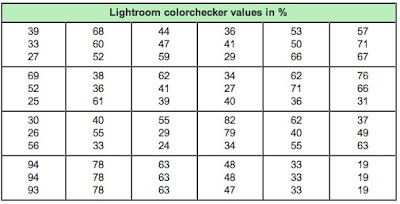THE COLORCHECKER PAGES (1/3) Looking for information on the ColorChecker? Here you will find: • Descriptions and pictures of the ColorChecker • Average ColorChecker data (from 30 charts) • A comparative analysis of measured ColorChecker data vs X-Rite values • ColorChecker image files in L*a*b* and RGB • Spectral curves and standard deviation data • 8-bit and 16-bit ColorChecker RGB values • A tutorial on how to compute RGB coordinates from measured ColorChecker data () Click to go to a section of interest: Page-1 (this page): (New section - 2016/01): (RGB coordinates, spectral data, Excel tables) (Updated - 2016/01) (BEFORE Nov.

2014 vs AFTER Nov. 2014) (New section - 2016/01) (individual charts vs average) (RGB and L*a*b*; 8/16-bit) (Updated - 2016/01): (Updated - 2016/01). These pages are not really related to BabelColor. Well, they are in the sense that BabelColor software is well adapted to, measure (on or ),, and ColorChecker targets. They are not related in the sense that the ColorChecker is the main subject of the page, that many products from other companies are mentioned, and because of the less informal tone used in the presentation.
In fact, this page, on-line since 2004, simply exists because of my longtime interest in the ColorChecker. But before we continue, just a small formality: ColorChecker is a registered trademark of, and X-Rite is a trademark. OK, back to the ColorChecker! Comments welcomed! Danny Pascale. A brief presentation The ColorChecker Color Rendition Chart, this very well known chart with an array of 4 x 6 color patches, is an icon of the imaging industry. It was formally presented in a 1976 article by C.
The chart’s manufacturer is compared to user-measured values. Subject terms: ColorChecker, RGB coordinates, RGB space, color space, color conversion. Introduction The ColorChecker1 chart is ubiquitous in the photographic and video fields. Its main application is for obtaining a rapid. How to Use the X-Rite ColorChecker Passport to Obtain Perfect Color. And opens up to display the color patches shown here. The ColorChecker Passport is.
McCamy and his colleagues from the Macbeth Company, a Division of Kollmorgen Corporation at the time: • C.S. Davidson, “A Color-Rendition Chart,” J. Ancient empires ii 320x240 jar. 3, Summer 1976, pp.

95-99, Society of Photographic Scientists and Engineers (Now called “The Society for Imaging Science and Technology (IS&T)”; ) Copies of the article are not available in IS&T online store but they can be ordered by sending an e-mail to Customer Service. A pdf of the scanned article is freely available from the Rochester Institute of Technology Web site ( ). Below, on the upper-left, is a photograph of Mr.
McCamy with the ColorChecker during a visit at the Munsell Color Science Laboratory, in 2002. In previous versions of this Web page, I challenged readers to try to improve it. This is a tricky image to correct; it is a JPEG made under fluorescent lights which was somewhat auto-corrected in the camera. Three reader submissions are shown in the other images. The ColorChecker is now sold by the Munsell division of X-Rite. Here is a timeline of how Macbeth, Munsell and X-Rite are related (principal info source: ): • 1915: Macbeth Artificial Daylight Company founded (New York, USA) (manufacturer of daylight fixtures) • 1918: Munsell Color Company founded (Boston, USA) (manufacturer of color standards based on the ) • 1965: Kollmorgen Instruments Corporation and Macbeth merge • 1970: Kollmorgen acquires the Munsell Color Company • 1976: ColorChecker developed by McCamy and al.
At Macbeth, a Division of Kollmorgen • 1997: The Gretag Color Control System Division of Gretag AG ((Switzerland) merges with Macbeth • 2001: Gretag-Macbeth becomes Amazys Holdings AG (Switzerland) • 2006: (USA) acquires Amazys Holding AG • 2012: (USA) X-Rite (Note: Danaher purchased a few years ago). The ColorChecker consists of a series of six gray patches, plus typical additive (Red-Green-Blue) and subtractive (Cyan-Magenta-Yellow) primaries, plus other 'natural' colors such as light and dark skin, sky-blue, foliage, etc. The color pigments were selected for optimum color constancy when comparing pictures of the chart with pictures of the natural colors. As reproduced on color film!
Top Pages
- Ayyappa Suprabhatham Mp3 Free Download
- Pdf Books For Mpsc
- Eztwain Pro 3 Crack Derby
- R&b Classics Collection 2008 Rar
- Download Anime Magic Knight Rayearth Sub Indo Star
- Slanted And Enchanted Luxe And Reduxe Rar Download
- Burnout Legends For Pc
- Best Service Chris Hein Horns Keygen Torrent
- Inventory Management System Project In Java Source Code Free Download
- Blofeld Software Editor For Mac
- Ciencia E Ingenieria De Los Materiales Askeland 6 Edicion Pdf
- Kimagure Orange Road Ost
- Samsung Syncmaster 450nb Manual
- Sinergy Suicide By My Side Rar
- Master Server Update Gta Samp